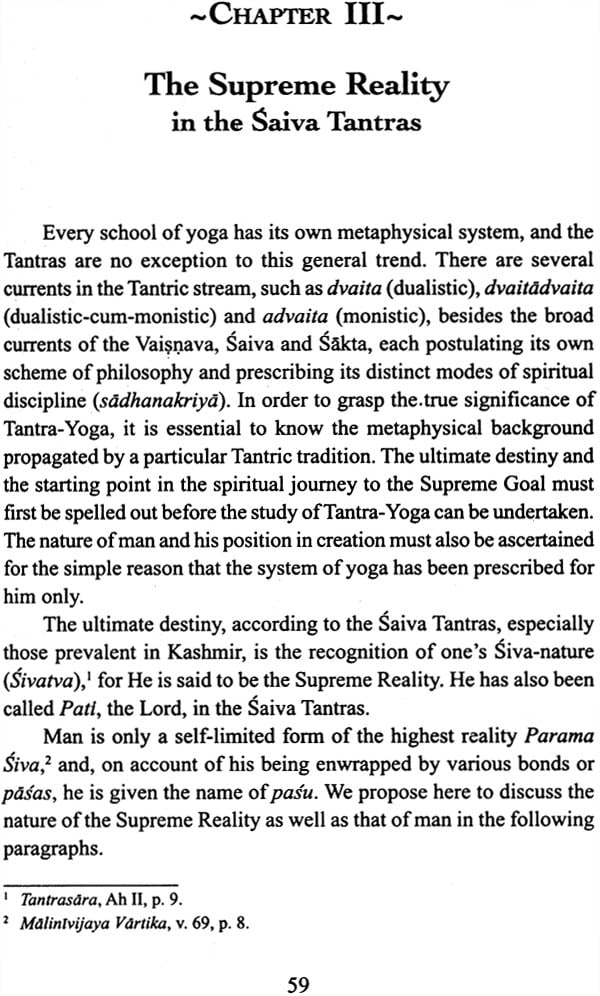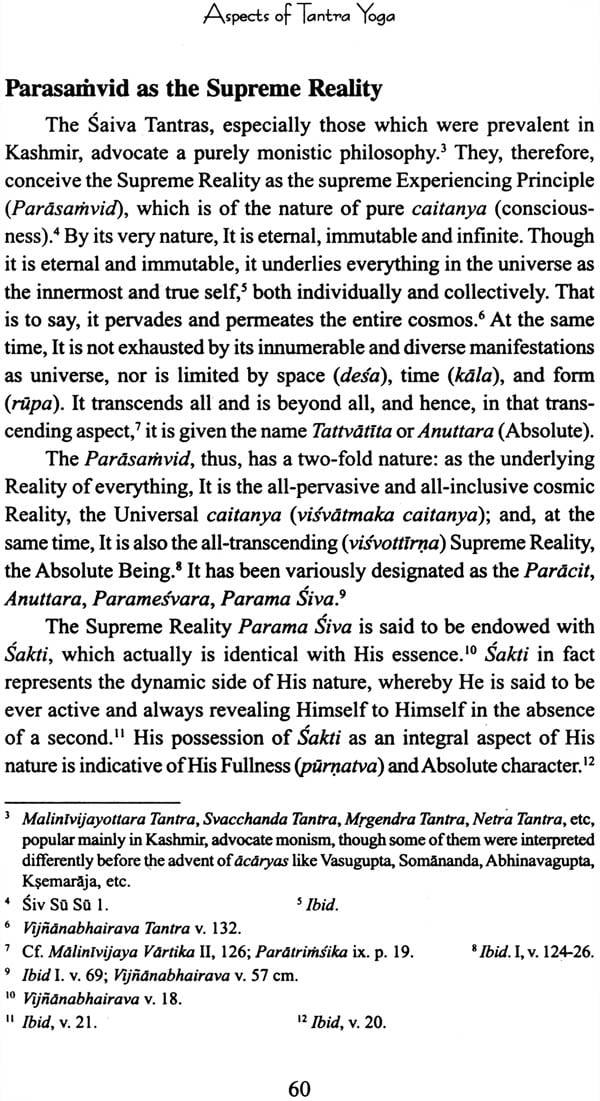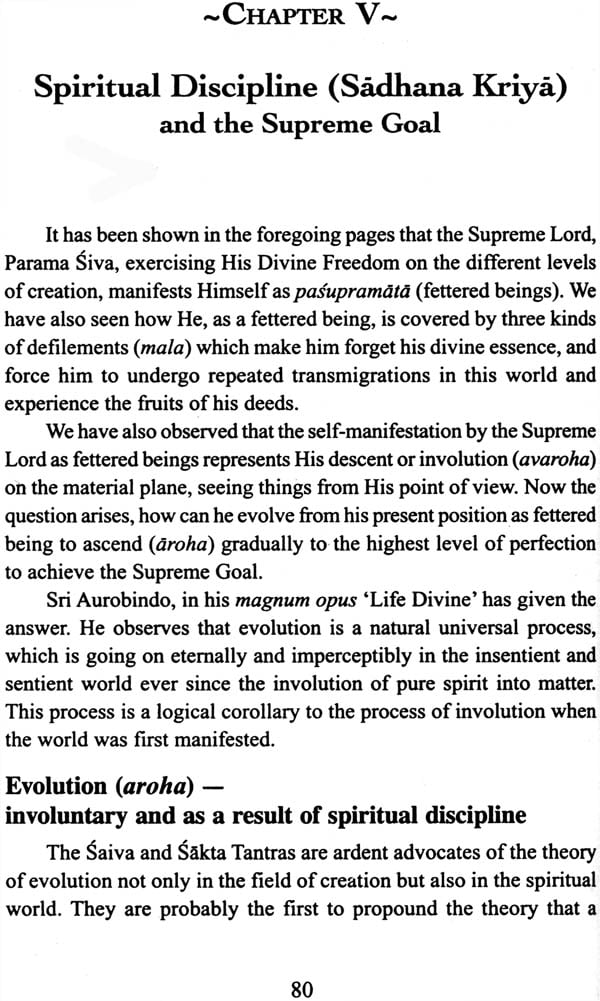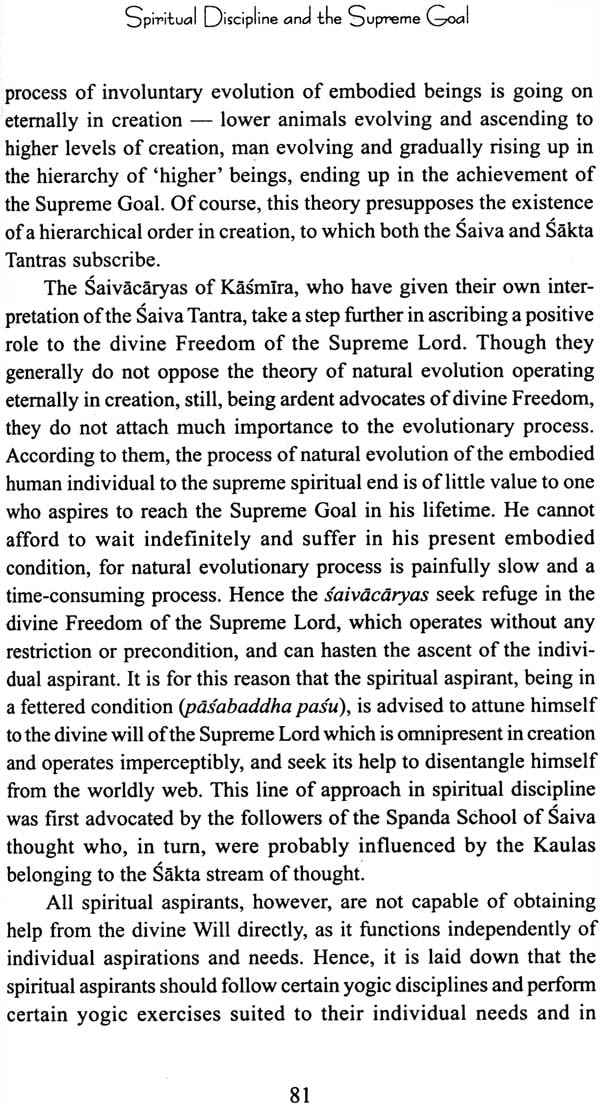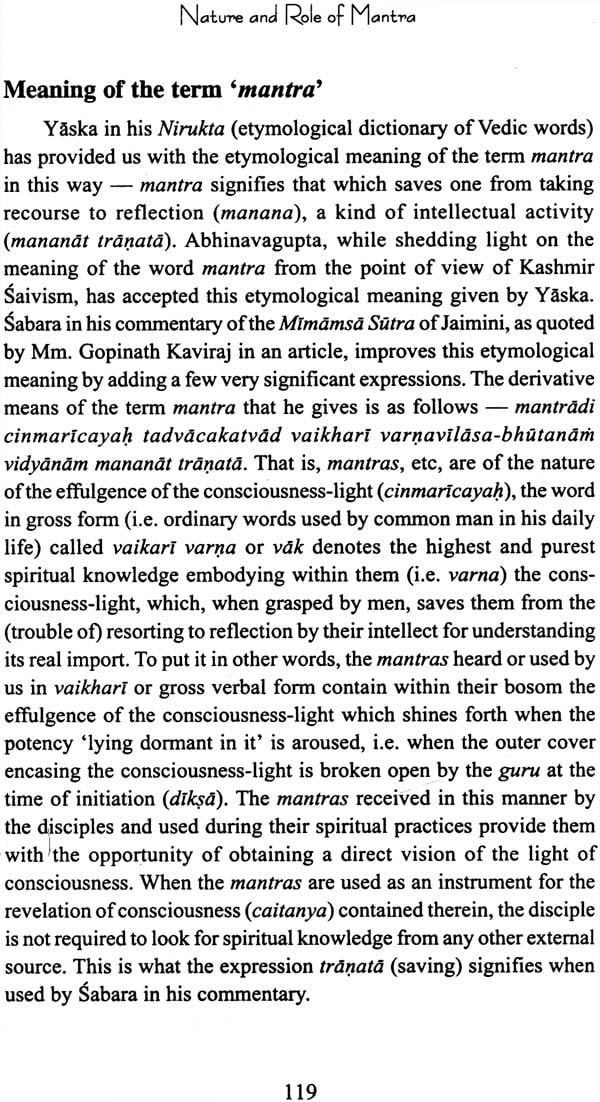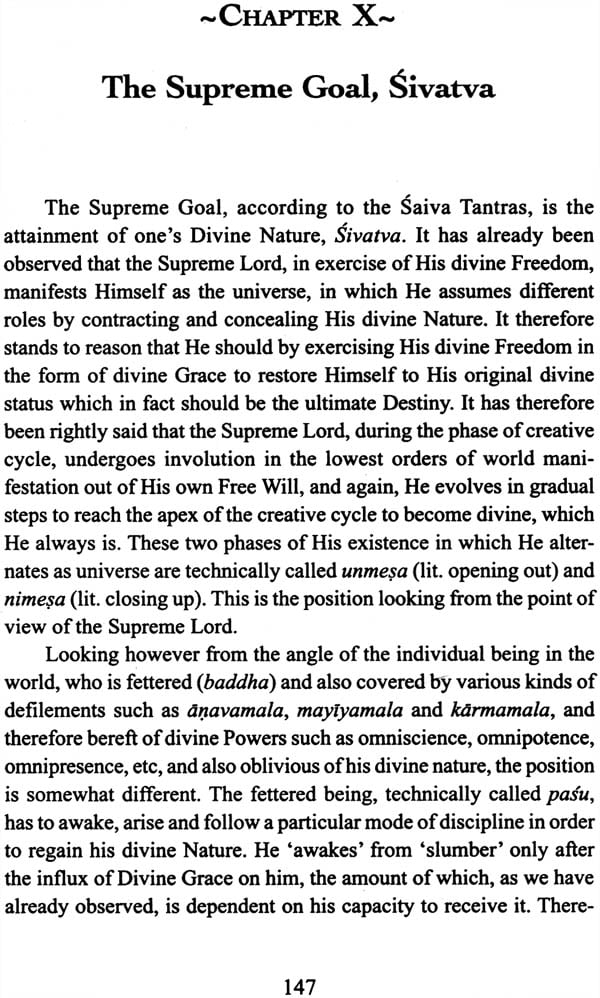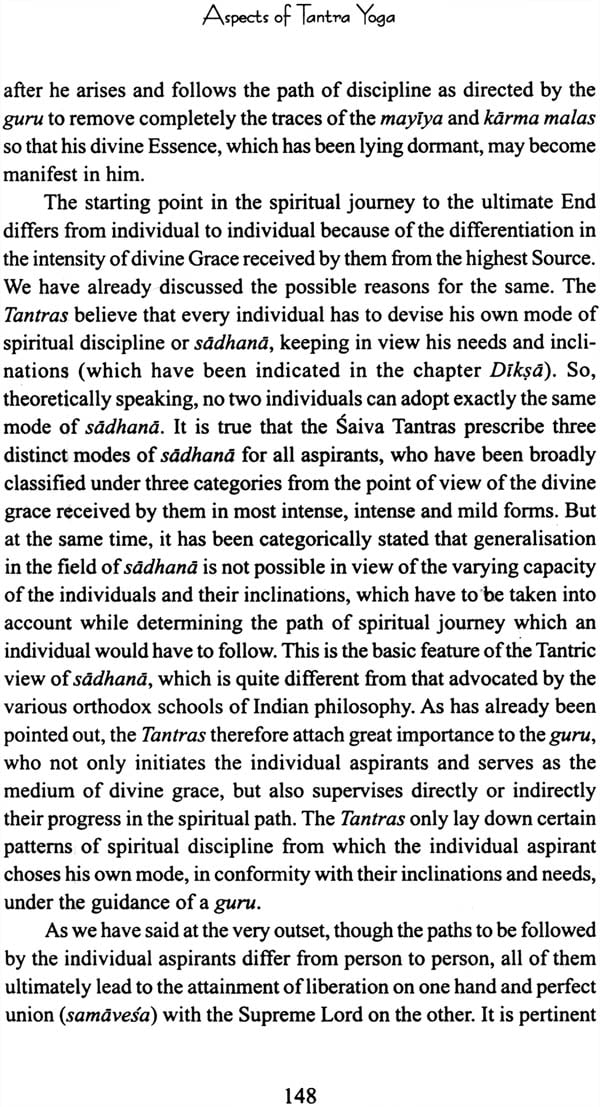
Aspects of Tantra Yoga
Book Specification
| Item Code: | IDJ758 |
| Author: | Debabrata SenSharma |
| Publisher: | Indica Books, Varanasi |
| Edition: | 2007 |
| ISBN: | 8186569677 |
| Pages: | 162 |
| Cover: | Paperback |
| Other Details | 8.4"X 5.3" |
| Weight | 220 gm |
Book Description
Back of the Book
The distinguishing feature of all schools of Indian philosophy in general is that these do not remain content with merely enunciating the metaphysical tenets of the particular school, but they also set up the spiritual goal before the seekers, prescribing the modes of spiritual discipline to reach it. Spiritual discipline or Yoga therefore constitutes an inseparable part of the philosophy of every school. This is very true especially in the case of Tantric school. This is very true especially in the case of tantric schools, in which spiritual practices or sadhana kriya dominate. The performance of kriya in the prescribed manner forms an integral part of all texts dealing with Tantra Yoga.
This book opens with an account of the nature, origin and development of Saiva-Sakta Tantras, their classification under different schools, etc. It also sheds light on the principal metaphysical tenets of Saiva and Sakta Tantras, relevant to the study of Tantra-Yoga. The topics covered in this book are the concepts of divine Grace or saktipata, guru and his different kinds, the process of initiation(diksa) and its varieties, mantra's nature and place in sadhana kriya, different modes of spiritual discipline, Kundalini Yoga, the highest spiritual goal, etc.
This book attempts to remove the misconceptions widespread in the academic world about the theory and practice of Tantra Yoga, which have been deliberately kept secret by the practitioners to prevent their misuse by unscrupulous persons.
Dr. Debabrata Sen Sharma, a well-known scholar of Sanskrit and Indian Philosophy and Religion, has spent more than half a century in studying, teaching and writing on the Advaita Shaiva thought of Kashmir. Retired as Professor of Sanskrit and Director of the Institute of Sanskrit and Indological Studies from the Kurukshetra University of Haryana, now settled down in Kolkata, he is devoting all his time to read in depth, write and translate Sanskrit texts on Shaivism. He had the rare privilege of studying abstruse Sanskrit texts on Shaivism and Tantra with Mahamahopadhyaya Dr. Gopinath Kaviraj, an acknowledged authority on Saiva-Sakta Tantras and a spiritual master, for eight long years at Varanasi.
Preface
The distinguishing feature of Indian Philosophy in general is its pragmatic approach towards the problems of human life. It does not rest with merely postulating a metaphysical theory; it also formulates a way to reach the Supreme Goal in life. Every School of Indian thought, therefore, prescribes a mode of spiritual discipline commensurate with its own conception of the ultimate Reality, and this is given the name of Yoga. The yogic discipline thus constitutes an integral aspect of the metaphysical theory of all schools of Indian thought.
There were different schools of yogic thought in the pre-Patanjali era, though very little is known about them due to non-availability of literature pertaining to them. Therefore Patanjali is given the credit of systematising concepts relating to yogic practices that were formulated before him as well as providing the necessary metaphysical background. The yogic discipline prescribed by him became so popular that the then prevailing other modes or spiritual discipline could not gat currency. Hence, the system of Yoga became synonymous with Patanjala Yoga Darsana.
The discoveries made by archaeologists at different prehistoric sites like Mohenjodaro, Harappa, Kalibangan, Lothal etc reveal that the people practiced some kind of yoga even in these pre-historic times, as is evident from of the seals found there. The Tantrika tradition, which appears to have some connection with the Atharvaveda, did exist in the beginning in the form of cults in which various modes of spiritual discipline dominated. The metaphysical theories in support of the spiritual goals visualized by the practitioners of Tantra Yoga developed much later, which is evident from the fact that the available Tantrika literature is of much later date. It is significant to note that most Tantrika texts pay more attention to the depiction of the kriya aspect, the practical aspect - a fact which supports our hypothesis that the Tantrika tradition, both Saiva and Sakta, prevailed in the beginning only in the form of cult.
As a student of Indian philosophy and religion, I was attracted towards the study of Tantra Yoga while doing research on the spiritual discipline according to Kashmir Saivism under the supervision of late Mahamahopadhyaya Dr. Gopinath Kaviraj, a well known savant and exponent of tanrism. I studied some Tantric texts with him, which gave me insight to the mysteries to Tantra yoga and inspired me to continue my studey of the Saiva and Sakta Tantras, which have many things in common.
In this book I have chosen to highlight a few important aspects related to the Tantras Yoga, e.g. the concepts of highest spiritual Reality, man and his nature, the concept of guru, divine grace, initiation, the Supreme Goal etc., which are important for a student of philosophy of religion to know. I have refrained from giving details of the Tantric practices, which are generally kept secret lest these should be misused. The Tantrika texts are generally replete with such descriptions. My approach to Tantra Yoga has been intellectual and academic, hence I have relied more on such Tantrika texts as the Malinivijayottara Tantra, the Svacchanda Tantra, the Vijnanabhairava Tantra, the Netra Tantra, the Tantraloka and the Tantrasara as these give the metaphysical details underlying Tantra Yoga.
I have also made an attempt to give a brief account of the extent of Tantric literature in the first chapter entitled 'Tantra', its meaning, scope and extent. Vast Tantric literature was produced under the Saiva and Sakta tradition but unfortunately most of it is either lost or remains unpublished.
I have used Sanskrit terms frequently but reluctantly, for want of suitable synonyms in English. The Tantras lean heavily to the mystical side and use such terminology which cannot be adequately translated into English. However, I have given English equivalents in parenthesis wherever possible, besides the Glossary at the end.
I consider it my duty to acknowledge the debt of my gratitude to my guru late Mahamahopadhyaya Dr. Gopinath Kaviraj who initiated me to the Tantric lore; to his valuable works for understanding the deep spiritual meaning underlying the various Tantric practices; to Sir John Woodroffe for his learned pioneering works in the field of Tantric studies.
I am also grateful to my teacher Dr. Govinda Gopal Mukhopadhyaya for inspiring me to undertake this work and showering his blessings. He has been pressing me to share with interested readers the knowledge I gained from my teaching and the study of abstruse tests over the years.
I express my gratefulness to Mr. Alvaro Enterria, Publications Director, Indica Books, for carefully going through the manuscript and suggesting many improvements in the book. I am also thankful to Shri D.K. Jaiswal, Director of Indica Books, Varanasi, for kindly undertaking the publication of this book and seeing it through the press.
Last but not least, I am also thankful to my wife Mrs. Dipika SenSharma for the support she has been giving in the production of this book.
I am conscious of my limitations, for which I solicit apology from my readers. Despite all care many errors in printing might have crept in, from which I crave their indulgence.
| Blessing | 11 | ||
| Abbreviations | 12 | ||
| Preface | 13 | ||
| Chapter I | Tantra- its Meaning, Scope and Extent | 17 | |
| What is Tantra | 17 | ||
| Origin of the Tantras | 19 | ||
| Scope of the Tantrika cult | 22 | ||
| Origin and development of the Tantrika literature | 23 | ||
| Division of the Tantrika tradition | 25 | ||
| Saiva Tantrika literature | 25 | ||
| Sakta Tantrika schools | 32 | ||
| Sakta Tantrika literature | 34 | ||
| Sakta Tantrika schools | 41 | ||
| Chapter II | Salient Features of the Language of the Tantras | 52 | |
| Chapter III | The Supreme Reality in the Saiva Tantras | 59 | |
| Parasamvid as the Supreme Reality | 60 | ||
| Divine Sakti, her nature and role in the manifestation of the universe | 61 | ||
| Chapter IV | Nature of Man in the Saiva Sakta Tantras | 70 | |
| Man, a self-manifested form of the Supreme Reality Defilements(malas), the cause for the manifestation of limited beings | 71 | ||
| Anavamala | 71 | ||
| Mayiyamala | 75 | ||
| Karmamala | 77 | ||
| Chapter V | Spiritual Discipline (Sadhana Kriya)- and the Supreme Goal | 80 | |
| Evolution (aroha) - involuntary and as a result of spiritual discipline | 80 | ||
| Steps leading to the attainment of the Supreme Goal | 82 | ||
| Chapter VI | Saktipata and Guru | 89 | |
| Saktipata and its role in spiritual discipline | 89 | ||
| Guru (divine teacher) and his kinds | 96 | ||
| Chapter VII | Diksa (Initiation) | 103 | |
| Diksa, its meaning and role in spiritual discipline | 103 | ||
| Kinds of diksa | 104 | ||
| Chapter VIII | Nature and Role of Mantra in Spiritual Practices in the Tantrika Tradition | 118 | |
| Meaning of the term 'mantra' | 119 | ||
| Kinds of mantra and their use in sadhanakriya | 120 | ||
| Chapter IX | Modes of Spiritual Discipline (Sadhanakriya) in the tantrika Tradition | 127 | |
| Upayas (modes of spiritual discipline) | 129 | ||
| Nature of Prana and its use in sadhana (pranoccara) | 131 | ||
| Treatment of Prana in some select ancient Upanisads | 132 | ||
| Nature of prana in some schools of Indian Philosophy | 134 | ||
| Nature of prana and its place in sadhanakriya in the Agamic tradition | 136 | ||
| Chatper X | The Supreme Goal, Sivatva | 147 | |
| Select Bibliography | 151 | ||
| Glossary | 155 | ||
| Index | 158 |
